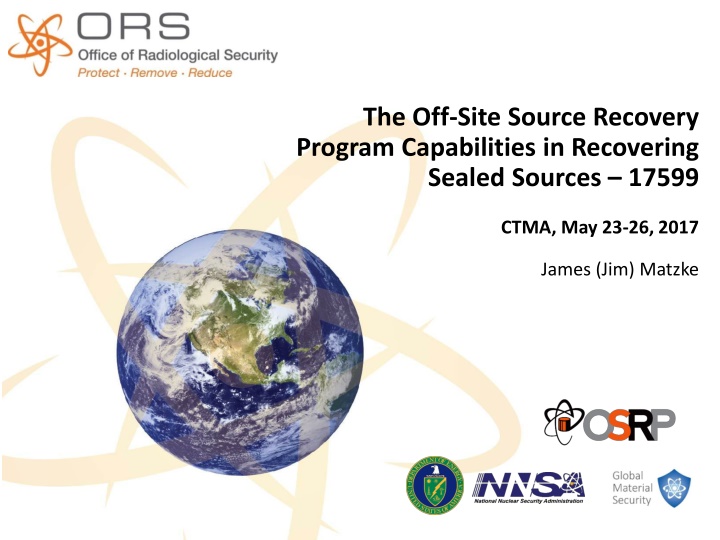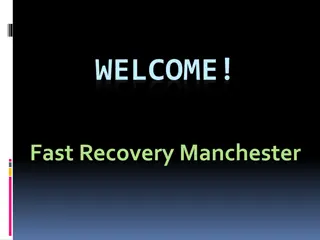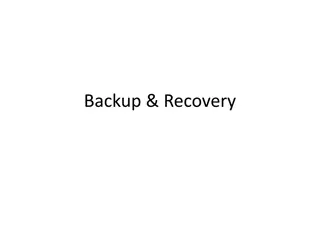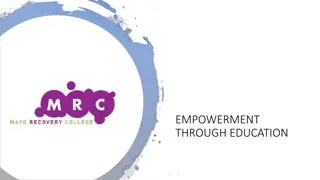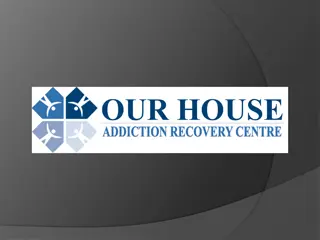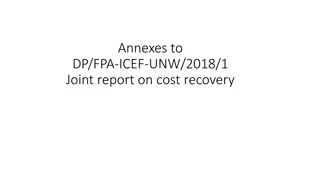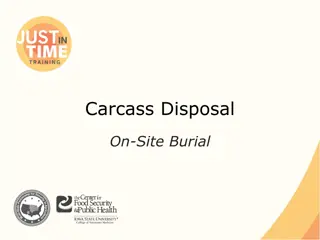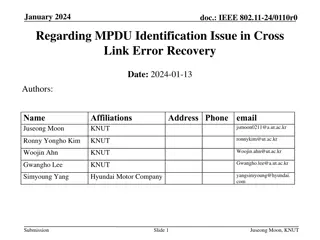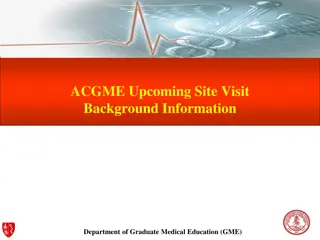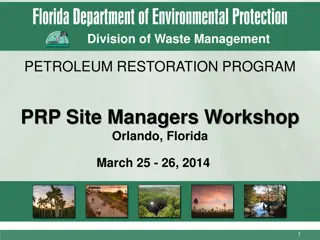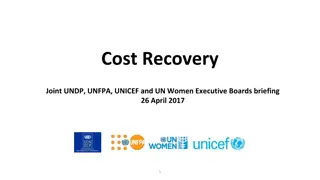Overview of Off-Site Source Recovery Program Capabilities
The Off-Site Source Recovery Program (OSRP) aids in recovering radioactive sealed sources for national security and public health. OSRP focuses on recovering TRU and non-TRU sources, with over 38,500 sources retrieved globally. Services include source registration, consultancy, and training for various licensees in industries such as hospitals, universities, and governmental sites. Different recovery types and source applications are addressed, showcasing OSRP's extensive operations worldwide.
Download Presentation

Please find below an Image/Link to download the presentation.
The content on the website is provided AS IS for your information and personal use only. It may not be sold, licensed, or shared on other websites without obtaining consent from the author.If you encounter any issues during the download, it is possible that the publisher has removed the file from their server.
You are allowed to download the files provided on this website for personal or commercial use, subject to the condition that they are used lawfully. All files are the property of their respective owners.
The content on the website is provided AS IS for your information and personal use only. It may not be sold, licensed, or shared on other websites without obtaining consent from the author.
E N D
Presentation Transcript
The Off-Site Source Recovery Program Capabilities in Recovering Sealed Sources 17599 CTMA, May 23-26, 2017 James (Jim) Matzke
Background on OSRP Recoveries OSRP s mission 16 years of recovering excess, unwanted, abandoned, and orphaned radioactive sealed sources in the interest of national security and public health and safety OSRP is sponsored by the NNSA Office of Global Material Security s Office of Radiological Security Recovery of TRU, US origin, defense-related sources (Pu- 239, Pu-238, Am-241, Cf-252, Cm-244) and non-TRU not commercially disposable sources (Sr-90, Cs-137, Co-60, Ir-192, Ra-226) 2
Sealed Sources Recovered by Isotope 67% of the sources recovered are TRU 26% of the sources recovered are high-activity beta-gamma 3
OSRP Operations Worldwide Source Recovery, Consultancy, Training 4
Source Registration OSRP helps licensees register and qualify sources for recovery Globally, over 3000 sites have registered more than 70,000 sources OSRP has recovered nearly 38,500 disused and unwanted sources Register sources at osrp.lanl.gov 5
Types of Source Recoveries Single site recovery typically one site with a large number of sources Multi-site round-up recovery typically several licensees with less sources per site Self-ship recoveries licensee assisted shipping of few sources 6
Types of Licensees and Source Applications Licensees: private industry, universities, hospitals, DOE labs, and other governmental sites Applications: industrial radiological devices (moisture- density, thickness gauges etc.), medical devices (blood irradiators, radiotherapy), research, nuclear power plants, etc. IBL 437 C JLS Mark 1 IPL Am-241 XFB-3 7
Source Recovery Sites in FY16 13 14 1 DOE Site DOD Site Federal Agency Foreign Entity Hospitals Industry Universities 1 5 15 34 8
Steps Towards TRU Source Eligibility Register excess and in-use sources at osrp.lanl.gov In most cases OSRP covers the cost for source recovery TRU sources that have US origin and satisfy WIPP Acceptable Knowledge (AK) criteria for source information Drums packaged for WIPP must have a decayed activity greater than 100 nCi/g for TRU isotopes and a contact dose rate <200 mrem/h OSRP performs an average of 40-50 recoveries per FY 9
Type A Packaging Used for WIPP Source Disposal Component S100 Drum S300 Drum 12 Pipe Overpack Standard 55 gal. drum & rigid liner Yes Yes Yes Pipe Component Diameter 6 12 12 Internal Shield Insert Yes Yes No Shield Outside Pipe Component (Neutron Shield) Yes No No Outer Fiberboard Pkg No Yes Yes Main Uses Neutron Sources, Small Volume, Less Sources Type A Fissile packaging, Special Form USA/9329/AF-96 Alpha or Shielded Neutron Sources, Larger Volume, More Sources 10
Drums Used for TRU Source Packaging S100 S300 12 POC 11
Packaging and Shipment of TRU Sources OSRP has authorized shippers to facilitate shipment from licensees Different contact handled packaging configurations determined by: Total source activity Dose rate Source dimensions Shipments follow DOT regulations 49 CFR: Normal form sources over A2 limit are encapsulated in Special Form Capsules (SFCs) Special form sources under A1 limit 12
Type of SFC Models for TRU Packaging Special Form Capsules: Model I, Model II, Model III have different internal volume and limits on source activity and weight loading 13
Self-Ship Recovery Option Licensee packages and ships the sources to an interim staging site Licensee must use a shipper trained to DOT requirements Ideal option for licensees who want to expedite the removal of their sources AK and activity under A value DOT limit requirements must be met OSRP can provide Type A drums for self-ships 14
High Activity Beta-Gamma Source Eligibility for Recoveries Register both excess and in-use sources at osrp.lanl.gov Prioritization is based on source activity, proximity to populated areas and site security OSRP establishes contracts with a commercial vendor for high-activity device removal OSRP recovers an average of 15-20 high-activity beta- gamma device removals per FY 15
Containers for Beta-Gamma Recoveries 435B Drop Testing of Test Unit 435B Production Unit 16
Packaging and Shipment of Beta-Gamma Sources Transportation of high-activity beta-gamma sources requires a certified Type B container Licensed vendors or commercial companies are used to remove and prepare the devices for shipment The self-ship option is an OSRP-assisted recovery where licensees ship the sources to a consolidation site, at which point ownership is assumed by OSRP 17
High Activity Beta-Gamma Recoveries 10-160B Container Operations 18
Type A Shipping Limits Isotope A1 Limit (TBq) A1 Limit (Ci) A2 Limit (TBq) A2 Limit (Ci) Pu-239 10 270 1E-3 0.027 Pu-238 10 270 1E-3 0.027 Am-241 10 270 1E-3 0.027 Co-60 0.4 11 0.4 11 Cs-137 2 54 0.6 16 Sr-90 0.3 8.1 0.3 8.1 19
Summary of Recovery Options Source Activity < A2 Normal Form Type A Potential Self ship or OSRP On-Site visit Source Activity < A1 Special Form Type A Potential Self ship or OSRP Site visit A2 > Source Activity < A1 Normal Form Type A OSRP On-Site visit, requires Special Form Capsule Source Activity > A1 Type B 20
Number of Total Recoveries and Sources Collected each FY 90 3000 80 Number of Recoveries Number of Sources 2500 70 60 2000 50 1500 40 30 1000 20 500 10 0 0 2013 2014 2015 2016 Fiscal Year On-Site Recoveries Self-Ships Sources 21
Recoveries and Sources Collected Number of self-ships average 30 per FY, representing between 35-45% of total recoveries per year Average number of on-site recoveries is 45 per FY The ratio of TRU on-site recoveries to self-ships is close to 1.5:1; the high-activity beta-gamma ratio varied There have been more total TRU recoveries than high- activity beta-gamma recoveries The activity for beta-gamma sources recovered far exceeds that of TRU sources 22
Summary Self-ships and on-site recoveries both help licensees to dispose of their excess sources The compliant packaging of sources is determined by source activity, dimensions, and dose rate OSRP has many tools to help licensees to qualify sources for recoveries: source information, qualified shippers, etc. Many challenges lay ahead with qualifying more types of sources for disposal and resuming shipments to WIPP The need for OSRP recoveries will continue as long as licensees use devices containing radioactive sources 23
Do you have unwanted sources? Register sources at osrp.lanl.gov Register unwanted sources with OSRP for recovery consideration. Recovery is generally prioritized on the basis of activity and level of security. Where numerous sources of lower activity are present at a single location, consideration is given to the total activity from a security perspective. Registration of sources does not guarantee recovery by OSRP 24
Questions? OSRP Contacts at Los Alamos National Laboratory Becky Coel-Roback Ph: 505-667-7920 Fax: 505-665-7913 Email: becky_cr@lanl.gov Justin Griffin Ph: 505-606-0362 Fax: 505-665-7913 Email: jgriffin@lanl.gov 25
